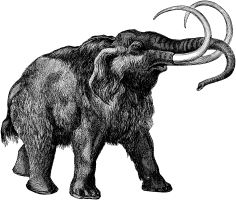Wooly Mammoth
A mammoth is any of a number of an extinct genus of elephant, often with long curved tusks and, in northern species, a covering of long hair. They lived during the Pleistocene epoch from 1.6 million years ago to around 10,000 years ago. more...
The word mammoth comes from the Russian мамонт ("mamont").
Evolutionary history
Mammoth remains have been found in Europe, Africa, Asia, and North America. They are believed to have originally evolved in North Africa about 4.8 million years ago, where bones of Mammuthus africanavus have been found in Chad, Libya, Morocco and Tunisia. Despite their African ancestry, they are in fact more closely related to the modern Indian elephant than the African elephant. The common ancestor of both mammoths and Asian elephants split from the line of African elephants about 6 - 7.3 million years ago. The Asian elephants and mammoths diverged about half a million years later (5.5 - 6.3 million years ago).
In due course the African mammoth migrated north to Europe and gave rise to a new species, the southern mammoth (Mammuthus meridionalis). This eventually spread across Europe and Asia and acrossed the now-submerged Bering Land Bridge into North America.
Around 700,000 years ago, the warm climate of the time deteriorated markedly and the savannah plains of Europe, Asia and North America gave way to colder and less fertile steppes. The southern mammoth consequently declined, being replaced across most of its territory by the cold-adapted steppe mammoth (Mammuthus trogontherii). This in turn gave rise to the woolly mammoth, Mammuthus primogenius) around 300,000 years ago. Woolly mammoth was better able to cope with the extreme cold of the Ice Ages.
The woollies were a spectacularly successful species; they ranged from Spain to North America and are thought to have existed in huge numbers. The Russian researcher Sergei Zimov estimates that during the last Ice Age, parts of Siberia may have had an average population density of sixty animals per hundred square kilometres - equivalent to African elephants today.
Extinction
Most mammoths died out at the end of the last Ice Age. However, the dwarf mammoths of Wrangel Island became extinct only around 1700 to 1500 BCE. Whether the general mammoth population died out for climatic reasons or due to overhunting by humans is controversial. A third theory suggests that mammoths may have fallen victim to an infectious disease. A definitive explanation has yet to be agreed upon, and it is very possible that a combination of factors was responsible rather than any of the single cause. The survival of the dwarf mammoths on Russia's Wrangle Island was due to the fact that the island was very remote, and uninhabited in the early post-Pleistocene period. The actual island was not discovered by modern civilization until the 1820s by American whalers. A similar dwarfing occured with Mammoths on the outer Channel Islands of California, but at an earlier period. Those animals were very likely killed by early paleo-indians.
Read more at Wikipedia.org


